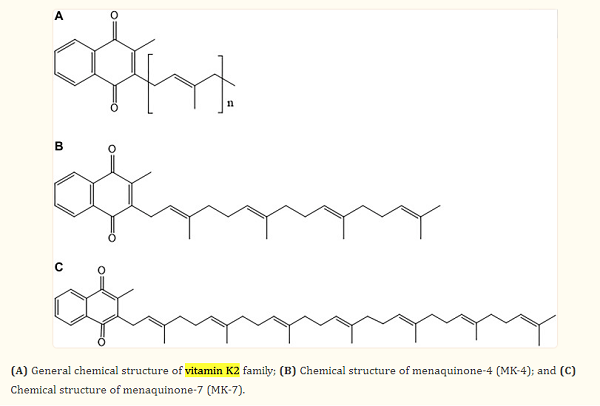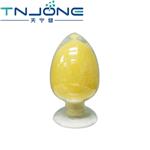Structure
Vitamin K2 is a fat-soluble vitamin that has the ability to cross the blood-brain barrier (BBB) due to its lipophilic nature. All the existing forms of vitamin K2 consist of a common moiety in their chemical structure, which is a 2-methyl-1,4-naphthoquinone ring. This core chemical structure of vitamin K2 is called menadione. Each form differs from the others with respect to the degree of saturation and length of side chains. Menaquinone (also called MK-n) differs in the length of its side chain, varying from 4 to 15 isoprene units; n denotes the number of isoprene units present in the structure. The figure depicts the chemical structures of members of the vitamin K2 family. The differences in side chains of different forms give each of them a unique potency and absorption efficiency. Menaquinones with the absence of methyl group on naphthoquinone moiety at position 3 are called dimethyl-menaquinones and serve as precursors to menaquinone.

Description
Menaquinone 7 (MK-7) is a vitamin K
2 analog that has been found in a variety of fermented foods. It increases osteocalcin, osteoprotegerin, and RANKL mRNA expression in osteoblastic MC3T3E cells. MK-7 (1 μM) increases alkaline phosphatase activity and calcium content in femoral-metaphyseal tissues isolated from normal and skeletal-unloaded rats.
In vivo, MK-7 (100 μg/g diet) inhibits aortic and myocardial calcification and decreases aortic alkaline phosphatase tissue concentrations in a rat model of extraosseous calcification. It also increases trabecular number, bone mineral density, and bone mineral content in a rat model of ovariectomy-induced bone loss.
Chemical Properties
Light Yellow Crystalline Solid
Uses
Vitamin (prothrombogenic)
Uses
Menaquinones are isoprenoid quinones of the naphthalene series and belongs to the K2 Vitamin homologs. Menaquinones were originally discovered as the anti-hemorrhagic factor and now encompasses a vari
ety of physiological processes. Menaquinone 7 belongs to the class of K2-Vitamins homologs. Menaquinone 7 has been identified as the most bioactive cofactor for the carboxylation reaction of Gla-prote
ins such as osteocalcin and matrix-Gla protein, which plays a crucial role in building and maintaining overall bone health.
Uses
Vitamin K2 (MK-7)-(5,6,7,8-d
4,2-
methyl-d
3) can be used as a stable isotope internal standard for data interpretation in specific biological samples.
Definition
ChEBI: A menaquinone whose side-chain contains seven isoprene units in an all-trans-configutation.
General Description
Vitamin K2, also known as menaquinone, is a polyisoprenoid-substituted?napthoquinone. Menaquinone-7 (MK-7) is a subtype of vitamin K2. It is found in animals, soy protein, fermented products and is primarily produced by bacteria.
Vitamin K2 (MK-7)-(5,6,7,8-d
4,2-
methyl-d
3) is a deuterated vitamin K2 wherein C-5, C-6, C-7, C-8, and 2-methyl protons are replaced by deuterium.
Side effects
Menlaquinone 7 is usually well tolerated and side effects are rare. Mild digestive symptoms, such as nausea, bloating or diarrhoea, may occur with overdose, but these side effects are usually temporary and will subside on their own. There have been some reports of allergic reactions to Vitamin K2 MK7, including skin rashes and breathing difficulties. As Menlaquinone 7 interferes with the action of blood thinners such as warfarin. Therefore, if you are taking blood thinners, be sure to consult your healthcare provider before taking Vitamin K2 MK7 or any other vitamin or supplement.
Therefore, if you are taking blood thinners, be sure to consult your healthcare provider before taking Vitamin K2 MK7 or any other vitamin or supplement.
Source
Vitamin K2, such as Menaquinone 7 (MK-7), can be obtained through natural fermentation and is shown to be the most superior form of K2. The main sources of menaquinones include animal-based foods like meat, fish, dairy products, etc. Short-chain menaquinones like MK-4 (having four isoprene units) are found majorly in animal-based food products. Menaquinones having long chains such as MK-7 to MK-13 are primarily synthesized by bacteria that include species of aerobic, anaerobic, facultative, as well as obligate anaerobic bacterial species that include Bacillus, Corynebacterium, Escherichia, Lactococcus and Vibrio. Some of these bacterial species are present as microflora in the gut. MK-7 or K2-7 is present in very high concentrations in a Japanese traditional food called natto. Natto is made by fermenting soybeans using Bacillus subtilis. Another source of menaquinones is the microflora of the intestine. Although intestinal synthesis has been shown to produce significant quantities of menaquinones, absorption from this source is inefficient to fulfill the required quantities. Menaquinone is analogous to ubiquinone in function as ubiquinone also contains isoprenoid side chains of varying lengths and, therefore, is used as an electron carrier in the electron transport chain by bacteria. Vitamin K2-7 is also detected in human milk samples depending on dietary intake[1].
References
[1] Nikita Jadhav. “Molecular Pathways and Roles for Vitamin K2-7 as a Health-Beneficial Nutraceutical: Challenges and Opportunities.” Frontiers in Pharmacology (2022): 896920.






